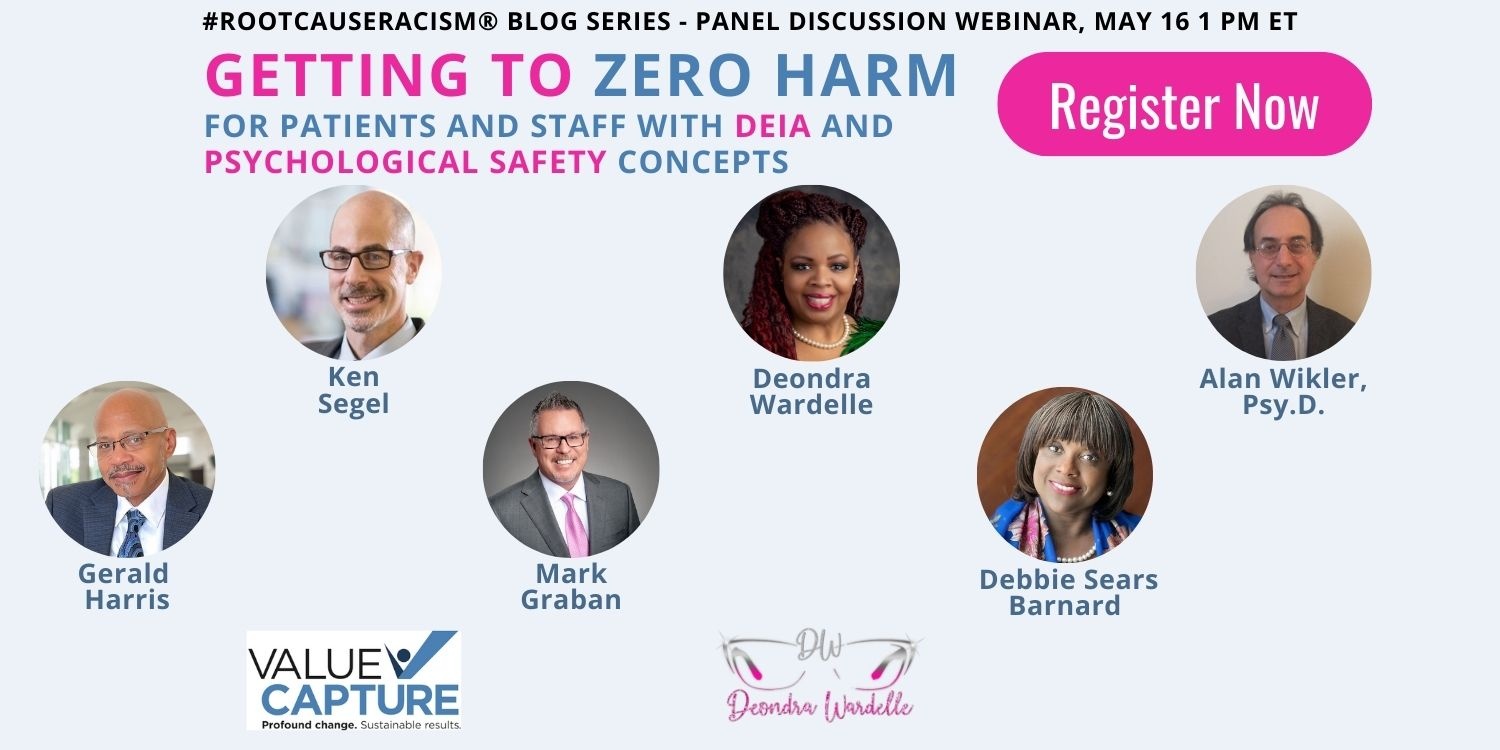This is the fifth blog post in the #RootCauseRacism series.
In 2001, the "Crossing the Quality Chasm" report highlighted the issues of poor quality care provided in America despite access to research and technology. Internationally, similar problems were also identified. Unfortunately, in 2023, the quest to achieve the benchmark of consistently providing care that is safe, timely, effective, efficient, equitable, and patient-centered continues to loom like a vast chasm still to be crossed.
“Crossing the Quality Chasm” remains an elusive goal for most health and healthcare organizations around the globe!
In the current environment, with the increasing focus on equity and disparities in healthcare and the negative impact of poor systems and operating processes on staff made more evident during the pandemic, leaders are called to address these issues that cause harm to staff and patients. The inability to consistently achieve positive outcomes for both staff and patients can no longer be attributed to the complex nature of healthcare delivery, the presence of multiple stakeholders with competing interests, and the difficulty of implementing evidence-based practices.
This blog series, "Getting to Zero Harm for Patients with DEIA and Psychological Safety," focuses on the intersections of these complex issues. Effective leadership, the psychology of change, and practical methods to measure and shape organizational cultures are critical in striving towards harm reduction and ensuring DEIA in healthcare organizations. Simplistic, siloed planning methods are no longer sufficient, as we must consider the unintended negative impacts on staff and the populations we serve.
While writing this blog post, I came across a quote attributed to Dr. Martin Luther King Jr. that struck a chord with me. He said:
"Rarely do we find men who willingly engage in hard, solid thinking. There is an almost universal quest for easy answers and half-baked solutions. Nothing pains some people more than having to think."
This quote resonates particularly in the context of achieving DEIA and Zero Harm in healthcare organizations. It's time for leaders to engage in more "hard, solid thinking" and shift their mindset and behavior to create meaningful change. We need to move away from easy solutions and prioritize thoughtful, intentional collaborative approaches to address the challenges we face in creating more equitable and safe healthcare systems. This will require a significant shift in the way we work and think, but it is necessary if we hope to cross the elusive chasm and achieve our goals.
We have the knowledge!
When it comes to creating organizations that prioritize harm reduction for staff and patients, there are a multitude of effective and practical resources available for organizations to use. With just a few minutes of searching on Google, credible evidence-based resources can be curated. Leading organizations such as the American Hospital Association (AHA), The Joint Commission, the World Health Organization, and the Institute for Healthcare Improvement have published a wide range of resources that can guide and inform organizations on their journey towards creating a more intentional focus on reducing harm. Here is a small sample of the resources available:
- Joint Commission Start Journey to Zero Harm Graphic
- Towards Zero Patient Harm in HealthCare
- Health Equity: Prioritization, Perception, and Progress
We know the challenge!
John Maxwell, “Everything rises and falls on leadership!”
Can leaders at all levels of the organization demonstrate their commitment to creating customer-centric, inclusive systems capable of consistently producing better outcomes for patients, staff, and the communities they serve?
Can we shift from “Yes, but” to “Yes, and”? For many, the article “The harms of promoting ‘Zero Harm’” by Dr. Eric J Thomas would serve as an easy excuse to say, “Yes, we want to adopt a Zero Harm approach, but here is the evidence that it’s not possible to achieve that goal.” I invite leaders to reflect on the conversations back in 2004 when the IHI 100,000 Lives Campaign was announced; many healthcare professionals felt that infections like Ventilator-Associated Pneumonia and Central Line Infections were unavoidable. We now know that with improvements in our systems of care, we can indeed drive these events to zero.
It is my hope that the well-thought-out arguments included in the article will positively challenge leaders to ask themselves some hard questions, (1) How clear is our Vision for Zero Harm, (2) Do we understand the work that we need to do? (3) Are we prepared to resource that work with the right staff equipped with the ability to identify and more effectively manage risks? And (4) Do we have the approach measurement systems that can cue us to our most vulnerable areas and help us to highlight successes along the journey? Let our response be, “Yes, and …..”.
The Work
When it comes to reducing harm and creating a more equitable healthcare system, it's important to take an interconnected approach that breaks down silos and focuses on a more collaborative approach to working. These ten steps are offered for reflection to help guide healthcare organizations in their transformation journey towards a more inclusive and safe culture. Leaders
Organizational Mindset
1) Leadership Engagement: All leaders at all levels must prioritize harm reduction for staff and patients as their number one priority.
2) Accountability System: Leaders must hold themselves accountable and coach others to deploy the system throughout the organization.
Shared Vision and Goals
3) Clarity of Vision: A clear vision for harm reduction should be set, with clear expectations. This vision and expectations should be communicated to all partners, including staff, patients, family, and the community.
4) Culture of Safety: Create a culture of safety that focuses on transparency and accountability, where safety is everyone's responsibility.
Collaborative Working – The Team
5) Patient Engagement: Engage patients in the co-design of customer-centric care models that support the delivery of respectful, culturally sensitive care. Integrate patients and partners at all levels of the system, including board committees, improvement team meetings, and recruitment and selection processes.
6) Recruitment and Retention Systems that Enable Workforce Diversity: Overcome barriers to diversity by focusing on the benefits, such as increased competitive advantage, improved decision-making, enhanced productivity, and innovation.
7) Diverse and Inclusive Culture: Create a culture of respect, collaboration, and empowerment to engage employees and foster their continuous development.
Collaborative Working – Our Shared Systems
8 Managing Variation: Build high-reliability health systems to ensure safety of processes. Equip teams to recognize sources of variation and use data to analyze and control it to improve processes. Monitor and measure progress towards goals.
9) Build Continuous Improvement Capability Building: Provide knowledge and confirm the competency of the team's ability to remove waste, eliminate defects, and contribute to the design and delivery of safe care systems. Tend to the psychology of change throughout the improvement and transformation process.
10) Culture of learning to drive innovation and improvement: Foster a culture of learning and encourage experimentation to drive innovation and improvement.
In conclusion, leaders at all levels must lead the way in taking action to close the knowledge-doing gap. By following these steps, healthcare organizations can create a culture that prioritizes harm reduction and DEIA while also building a solid foundation for innovation and continuous improvement.

Written by Debbie Sears Barnard, MSc., CPHQ
Debbie Sears Barnard is a certified Maxwell Leadership team member, based in Dubai, UAE, and serving clients globally through coaching, speaking, training, and consulting. Her goal is to co-create a world that works better for all. She leverages her expertise in lean systems thinking, strategy deployment, executive leadership development, and continuous improvement to assist leaders in gaining clarity and enhance strategic thinking to close the gap between knowledge and action, creating inclusive and psychologically safe workplaces where everyone can thrive. Debbie is an avid traveler, and her work has allowed her to serve organizations across North and South America, Europe, Asia, and the Middle East.


Submit a comment